The Versatile Applications of Small Blacklight Flashlights
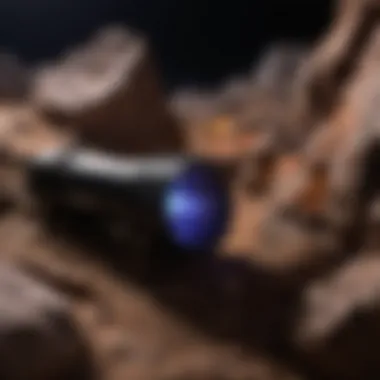
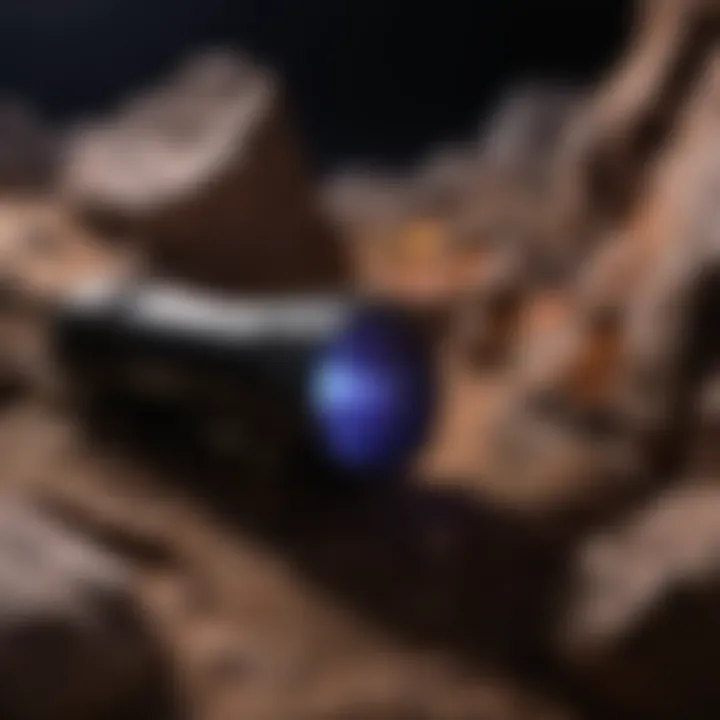
Intro
In a world buzzing with advancements in technology, small blacklight flashlights stand out as tools with layered applications that go beyond mere illumination. Whether you're a hobbyist exploring the depths of a cavern or a seasoned art appraiser looking for telltale marks on a masterpiece, these compact devices can significantly enhance your work. Their uses span various fields such as geology, art, pest control, and forensic science, creating a rich tapestry of functionality. In this article, we will journey through the multifaceted applications of small blacklight flashlights, diving deep into their relevance and utility.
Featured Collectible of the Month
Overview
Imagine trekking through remote areas, eyes peeled for unique specimens, and your trusty small blacklight flashlight guiding you. For rock and fossil collectors, these flashlights can illuminate features that are invisible to the naked eye, revealing unique mineralogical treasures. Among the more sought-after specimens, one can find the striking glow of certain fossils under UV light, making them particularly attractive to collectors and enthusiasts. One noteworthy collectible this month is the Fluorescent Calcite, known for its brilliant orange hue when exposed to a blacklight. Its rarity and distinctive glow make it a prized possession in any collection.
Historical Significance
The importance of small blacklight devices has evolved over the years. Initially, their applications were largely relegated to scientific pursuits, including geology and biology, helping researchers analyze mineral compositions and detect variations in organic materials. As the years progressed, artists began utilizing these tools for verifying authenticity, marking a crucial shift in their application. For example, embedded marks or signatures that are only revealed under certain light conditions became essential for appraisers assessing artworks. This historical evolution highlights the growing necessity of these tools across diverse fields, from humble beginnings aiding scientists to now being indispensable in various specialized practices.
Identification Techniques
Visual Characteristics
When it comes to selecting the right small blacklight flashlight, understanding its visual characteristics is paramount. Typically, these flashlights emit UV light that can range between 365 nm to 405 nm. Look for features like:
- Light Weight: Great for portability.
- Adjustable Brightness: Helps cater to specific needs in the field.
- Durable Construction: Resistance to wear from frequent use outdoors.
A well-designed blacklight flashlight can mean the difference between discovering a valuable specimen or missing it entirely in a dim-lit environment.
Resources for Identification
Finding the perfect blacklight flashlight, particularly for collecting purposes, is crucial. Here’s a list of useful resources:
- Wikipedia - Ultraviolet light
- Britannica - Fluorescence
- Reddit - Fossils and Geology
- Facebook - Rock Collectors Group
Each platform offers insights and discussions on identifying the right tools and tips from experts who share their experiences, aiding enthusiasts in navigating their requirements successfully.
By using a small blacklight flashlight, collectors unlock the hidden stories embedded in each specimen they encounter.
Prologue
Small blacklight flashlights, while often considered niche tools, play a crucial role across multiple fields. Their ability to emit ultraviolet light unlocks a world that is hidden under ordinary conditions. By using these compact devices, professionals and enthusiasts alike can unveil details in art, geology, forensics, and pest control that would otherwise go unnoticed. These insights enhance our understanding of both natural phenomena and human artifacts, making them invaluable in many contexts.
In the realm of geology, for instance, the use of blacklights can help highlight fluorescent minerals, guiding collectors in their quest to identify significant specimens. For art collectors, the same gadgets can reveal truths behind artistic authenticity, thus safeguarding investments against forgeries. The applications extend to more practical territories as well, such as pest control, where light detection methods are employed to monitor and combat infestations.
Moreover, a proper understanding of small blacklight flashlights allows users to make informed choices about the tools they use. Not all blacklights are created equal, and factors such as brightness, ease of portability, and design features can markedly affect the user experience. This article serves not just as a guide; it encapsulates the multifaceted uses of these versatile tools, discussing their potential and the thoughtful considerations for users—novices and seasoned experts alike.
The Concept of Blacklight
Understanding blacklight is essential to grasp the myriad ways in which these flashlights can be utilized. Blacklight, or UV light, operates at wavelengths that are invisible to the human eye. Specifically, ultraviolet light typically ranges from 10 nm to 400 nm, falling just outside the spectrum visible to humans. This light can make certain materials fluoresce, appearing to glow when exposed to it. It’s a fascinating phenomenon with numerous practical applications.
For example, some minerals contain fluorescent properties, resulting in stunning visual displays under UV light. This is especially relevant for rock and fossil collectors, who seek to identify and appreciate the nuances of their finds. Fluorescent specimens might only reveal themselves under the soft glow of a blacklight, providing a unique perspective on geological treasures.
Additionally, it’s important to note that not just any light will do; blacklights specifically designed to emit the correct wavelength are needed. Whether you are an amateur collector or a professional in any relevant field, understanding how blacklights work and their capabilities will significantly enhance your expertise.
"Small blacklight flashlights are not just tools; they are windows into a hidden world around us, revealing complexities that often go unnoticed."
Ultimately, the concept of blacklight combines science with practicality. As users become more adept at utilizing these tools, they can unlock hidden insights that have significant implications in their respective fields.
Characteristics of Small Blacklight Flashlights
When it comes to small blacklight flashlights, their unique characteristics set them apart from regular flashlights. These features not only contribute to their specialized applications but also enhance their functionality in various scenarios such as geology and art verification, making them indispensable tools in those fields. Understanding these attributes helps users make informed decisions in choosing the right blacklight flashlight for their specific needs.
Wavelength and UV Light
The wavelength is a critical factor that affects the performance of small blacklight flashlights. Most commonly, these flashlights emit ultraviolet (UV) light, typically in the range of 365 to 395 nanometers. This range is ideal for activating fluorescence in certain materials. For instance, when a blacklight shines on a calcite mineral, it may display vibrant colors due to its fluorescent qualities, thus enabling collectors to identify the specimen more readily.
- A flashlight with a wavelength of 365 nm is often more effective for mineral luminescence. It can make certain crystals glow in shades of pink, green, or blue.
- On the flip side, a flashlight with a wavelength closer to 395 nm is generally safer for human skin but may not produce the same vivid fluorescence in minerals.
So, when selecting a flashlight for geological purposes, understanding the impact of wavelength on fluorescence is key.
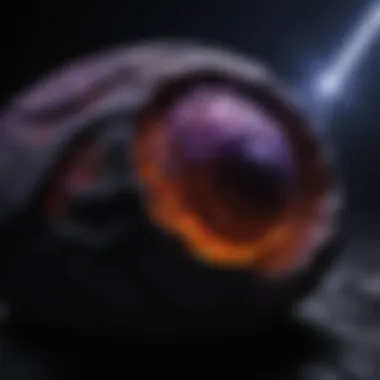
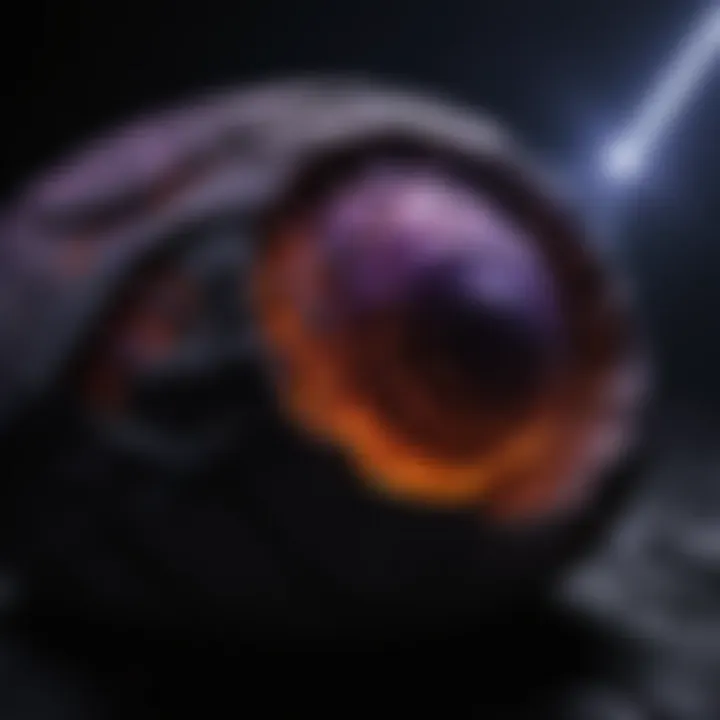
Portability and Design Features
Next up is the portability and design features of these handy devices. Given that geology enthusiasts often venture into remote areas during excursions, the size and weight of the flashlight become essential considerations. A small, lightweight flashlight can easily fit in a pocket or backpack, allowing for hassle-free transport.
- Many models come with ergonomic grips, making them comfortable to hold during extended use. Some even feature wrist straps to ensure you do not accidentally drop them while examining rocks.
- Additionally, durability is a crucial aspect. Many small blacklight flashlights are made from sturdy materials like aircraft-grade aluminum, providing protection against bumps and drops, something that’s inevitable on rocky terrains.
"Selecting the right flashlight can be the difference between discovering a noteworthy specimen and missing it entirely."
Whether you're a seasoned collector or a budding enthusiast, these characteristics are vital in enhancing your exploration journey.
Applications in Geology
The role of small blacklight flashlights in geology is not just a gimmick but an essential tool for both amateur rock hounds and seasoned geologists. These simple devices can illuminate a world that is otherwise hidden from the naked eye, allowing for a unique exploration of minerals and fossils lying beneath surface layers. When employed properly, a blacklight flashlight can be the difference between overlooking a rare specimen and uncovering something truly extraordinary.
Fluorescent Minerals
When examining rocks in the field, it's common to stumble upon minerals that exhibit fluorescence. This phenomenon occurs when certain minerals absorb ultraviolet (UV) light and then emit visible light. The impact of being able to spot these minerals cannot be understated. Some collectors have turned a mere day trip into a treasure trove of rare finds just by wielding a blacklight flashlight.
For instance, calcite and fluorite can light up a drab rock face, revealing glowing patches that are utterly captivating. This not only enhances the aesthetic value of specimens but also helps in identifying which minerals are present in a collection. By knowing which minerals fluoresce, one can build a more comprehensive understanding of the geology of their area.
Moreover, it's crucial to keep in mind that not all fluorescent minerals will display in every type of blacklight; the wavelengths emitted can vary. Thus, having a flashlight with adjustable settings could make a notable difference in your fieldwork experience.
"Fluorescent minerals are like nature's own neon lights, providing both beauty and a glimpse into geological history."
Identifying Rocks and Fossils
The identification of rocks and fossils is one of the most engaging aspects of geology, and kleinen blacklight flashlights have a significant role here as well. Under normal lighting conditions, subtle details on a rock's surface may go unnoticed. However, switch on that blacklight, and the differences stand out clearly.
Small blacklight flashlights can help distinguish between similar-looking specimens. For example, when trying to identify different types of limestone, the presence of certain fossils or minerals will often become more evident under UV light. Fossils that are often invisible or hard to discern may reveal themselves through fluorescence, while the matrix around them can take on a different appearance.
In addition, they can assist in authenticating fossils. Sometimes, a fossil may be coated in a resin or other material to enhance its appearance. A blacklight will often reveal discrepancies that can suggest manipulation. Identifying these attributes can offer valuable insight into not just the fossil itself, but the practices of fossil markets.
In summary, the applications of small blacklight flashlights in geology serve significant purposes. They enable geologists and collectors to discover rare fluorescent minerals, enhance identification processes, and even ascertain the authenticity of fossils. This multi-layered functionality brings a richness to the geological exploration experience and provides a deeper connection to the earth's hidden treasures.
Art and Antiques Authentication
The value of art and antiques extends beyond mere aesthetics; it encompasses heritage, history, and sometimes, hefty price tags. This makes art and antiques authentication a crucial inquiry that requires steady, informed practices. Small blacklight flashlights shine brightly—a fitting metaphor—and reveal hidden truths. The ability to distinguish genuine items from clever forgeries can safeguard collectors' investments and preserve cultural artifacts.
Blacklights expose how certain materials react under ultraviolet light, proving invaluable in the authentication process. For example, many artists used specific pigments that fluoresce when under blacklight, while forgers might choose to use alternative materials that lack the same properties. This section emphasizes the importance of using such tools not just for confirmation, but also for understanding the item's path through history and its rightful place in the world.
Detecting Forgery
The prevalence of forgery in the art world can make even the most experienced collectors wary. Utilizing a small blacklight flashlight can be a game-changer in this context. When shone on a painting or a sculpture, the light reveals aspects of the piece that may be invisible to the naked eye.
For instance, the presence of certain varnishes or new acrylics that glow under UV light can indicate a more recent creation rather than a genuine piece. Similarly, many older artworks have patinas that age them. When these pieces are examined, one might notice that forgers often neglect to replicate the aging process faithfully.
In short, blacklight flashlights can help identify inconsistencies in artwork. They uncover layers that tell stories of originality, dialogue from the past, and the unfortunate attempts to deceive. In today's market, this kind of knowledge could be the difference between acquiring a masterpiece and getting duped.
Assessing Condition and Restoration
Beyond the mere act of authenticating art, a blacklight can function as a robust tool for assessing the condition of art and antiques. Often, small repairs or alterations made to an object might go unnoticed in daylight. However, certain adhesives or coatings can reveal themselves under ultraviolet light.
When it comes to restoration, the objective is to maintain the integrity and spirit of the artwork. By shining a blacklight on a piece, restorers can evaluate any prior interventions. This reveals patches, touch-ups, or repairs that may have been performed and helps to ensure any future work is compliant with best practices that respect the original work.
In this nuanced field, understanding the object's present condition is paramount. Collectors should be equipped with the knowledge that a simple tool can facilitate comprehensive assessments—paving the way for responsible stewardship.
Remember, the art of authentication relies heavily on attention to detail. Small blacklight flashlights are a step toward that very goal.
Pest Control Applications
Pest control is a domain where small blacklight flashlights prove to be more than just an intriguing gadget; they serve an essential role in managing and investigating pest problems. Utilizing these devices can elevate the effectiveness of pest management strategies by allowing professionals and homeowners alike to uncover hidden infestations and identify pest trails that could otherwise go unnoticed. This becomes particularly vital when pests are stealthy or active in dark areas, such as basements or attics, where traditional lighting fails to reveal crucial evidence.
Detecting Insect Trails
One of the significant advantages of employing blacklight flashlights in pest control is their ability to detect insect trails. Many insects leave behind traces of secretions, droppings, or even shed skins that can glow under UV light. This characteristic is particularly true for species like termites and various beetles. By shining a small blacklight onto potential nesting areas, a pest control expert can quickly identify where these insects have traveled.
- Spotting Glow: The slick sheen of mold or decay may attract certain pests, but the actual trails they leave behind can often be missed in regular light.
- Targeted Treatments: Knowing where insects have been allows for precise treatment applications like bait stations or insecticides, making the pest management process more efficient and less wasteful.
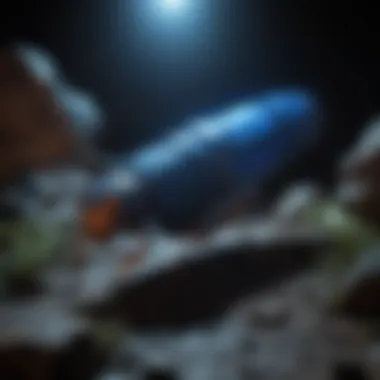
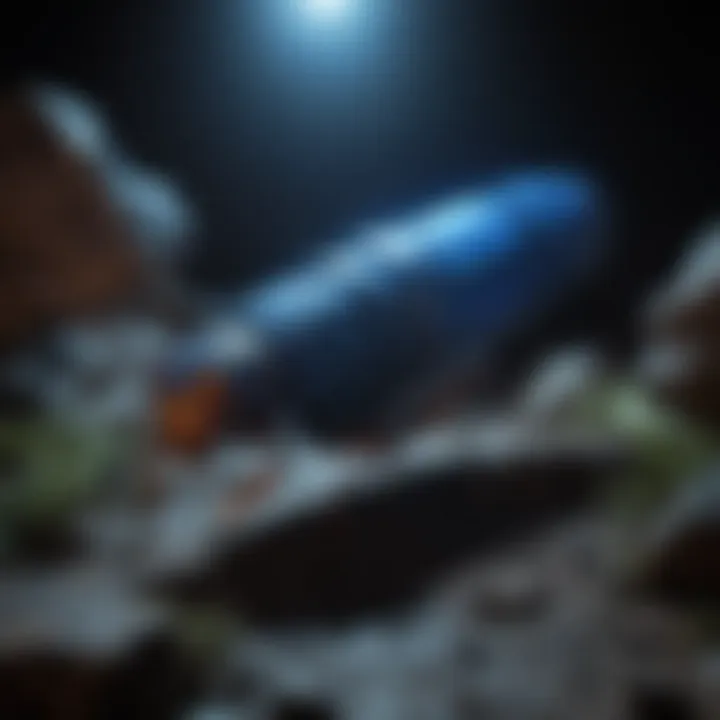
A skilled pest controller will often develop a habit of using blacklights during inspections, looking for that characteristic fluorescent glow of trails, which can lead to quicker resolutions and less frustration for the homeowner.
Monitoring Infestations
Monitoring pest populations is another critical use of small blacklight flashlights. Once an infestation is identified, ongoing monitoring becomes essential to gauge its development and response to treatment. The fluorescent properties of insect waste and other biological materials can be fundamental in tracking the effectiveness of pest control methods.
- Visual Monitoring: The presence of glowing droppings in previously treated areas can act as a telling sign that pests are not entirely eliminated, necessitating further action.
- Behavioral Insight: Often, UV light can reveal the habits and movement patterns of pests. Understanding where they prefer to venture can assist in modifying environments or adjusting treatment techniques.
Additionally, regular use of blacklight flashlights in monitoring settings can make problematic areas more apparent, allowing for timely interventions. Pest control professionals can thus work proactively, preventing small issues from morphing into full-blown infestations.
"Utilizing small blacklight flashlights for pest control not only enhances detection but empowers effective intervention, preventing significant damage to homes."
The integration of blacklight flashlights in pest control strategies is a game changer, presenting an innovative avenue to take on traditional problems in modern ways. As many homeowners seek more effective and environmentally conscious solutions, understanding these applications can lead to lasting control methods and healthier living spaces.
Forensic Science Utilization
In forensic science, small blacklight flashlights play a pivotal role. Their unique capability to reveal hidden evidence makes them an indispensable tool for crime scene investigations. These flashlights emit ultraviolet (UV) light, causing various substances like bodily fluids and trace materials to fluoresce. This ability is critical in gathering evidence that might otherwise go unnoticed by the naked eye. For instance, a simple spot on the floor could become a vital piece of evidence once illuminated by a small blacklight flashlight. Such detection not only aids in solving crimes but also enhances the accuracy of evidence collection.
Blood and Biological Fluids Detection
Detecting blood and other biological fluids at crime scenes is one of the foremost applications of small blacklight flashlights. When a crime occurs, the evidence left behind can be crucial for legal proceedings. UV light makes blood stains glow, even when they are faint or partially washed away.
Using these tools, forensic technicians can identify potential evidence areas that they would not be able to see under normal lighting conditions. This identification is not limited to blood; it can also detect urine, saliva, and other bodily fluids. By illuminating these stains, investigators can not only establish the presence of such fluids but also potentially link them to a suspect or victim. This process demands precision and careful documentation, as every mark offers insights into the scenario being investigated.
Evidence Collection and Analysis
Once evidence is detected, the next step is careful collection and analysis. The efficiency and effectiveness of this process can greatly impact the outcome of a case. One key benefit of utilizing a small blacklight flashlight during evidence collection is that it allows for the identification of multiple types of fluids or materials simultaneously. For example, substances such as seminal fluid or certain paints can also be illuminated under UV light.
Careful protocols must be followed during this stage:
- Photographic Documentation: All findings should be photographed under both normal and UV light conditions.
- Preservation Techniques: Evidence needs to be collected in a way that preserves its integrity, avoiding contamination.
- Chain of Custody: A meticulous record of everyone who handles the evidence is essential to maintain its legitimacy in court.
Small blacklight flashlights significantly enhance forensic investigations, transforming how evidence is discovered and analyzed.
The overall importance of small blacklight flashlights in forensic science cannot be overstated. They allow for a higher degree of thoroughness in detecting evidence, which can play a crucial role in bringing justice. Whether it’s in a criminal investigation or other forensic applications, the benefits of using these specialized tools are evident. Collectors and enthusiasts should recognize that these flashlights not only belong in the toolkit of investigators but can be beneficial across multiple contexts.
Selecting the Right Small Blacklight Flashlight
Choosing the right small blacklight flashlight is essential for users who want to maximize the value of their investments in both basic and specialist applications. Whether you're a rock hound searching for that elusive fluorescent gem, or an antique dealer on the lookout for subtle clues about authenticity, the right flashlight can make all the difference. A proper selection not only enhances the effectiveness of your undertaking but also ensures safety and user satisfaction. Here, we delve into the important factors that help you choose the best flashlight for your specific needs.
Assessing Quality and Brightness
When it comes to small blacklight flashlights, quality and brightness are paramount. High-quality flashlights produce a more focused beam of UV light, which is crucial in applications such as geology and forensics. A poorly made light might not reveal the vibrant hues of minerals or could fail to highlight biological stains effectively.
Brightness, measured in watts or lumens, determines how well you can see the fluorescent responses. It's wise to lean towards devices with adjustable brightness settings. This is particularly handy during field work; one minute you're examining a dark cave floor, and the next, you could be in bright sunlight. Having the ability to dial up or down the intensity can prevent wasted battery life and provide the right visibility according to your environment.
To put things into perspective, low-quality flashlights tend to offer a sparse range of wavelengths and uneven intensity, which can lead to inaccurate results.
Preferred Features and Functions
Selecting a small blacklight flashlight should also take into account various features that enhance usability.
- Durability: A flashlight made from robust materials like aluminum or impact-resistant plastics is ideal for outdoor use, making it resistant to drops and shocks.
- Water Resistance: A flashlight with an IP rating, indicating its water resistance, is essential for those who venture into wet environments. You wouldn't want a little splash ruining your tool.
- Battery Type: Consider if you prefer rechargeable batteries or disposable ones. Many modern models offer both options, allowing for flexibility in usage.
- Weight and Size: Since portability is key, check whether the flashlight fits comfortably in your bag or pocket. You wouldn't want to lug around an unnecessarily heavy device while on a rock-hunting expedition.
- Filter Options: Some flashlights come with interchangeable filters that allow you to adjust the type of light being emitted, which can be useful in changing conditions or for different materials.
"The flashlight might be small, but its impact can be immense when you know what to look for."
Ultimately, selecting the right blacklight flashlight is about aligning the features of the tool with your objectives and the environments you'll be working in. Mindful consideration of the above factors can lead you to the flashlight that doesn’t just meet, but exceeds your expectations.
Maintenance of Blacklight Flashlights
In the realm of small blacklight flashlights, maintenance is not just a trivial concern; it's essential for ensuring longevity and optimal performance. Regular care plays a pivotal role in making sure these specialized tools deliver their intended results every time you pull the trigger. For rock and fossil collectors, such flashlights often reveal details that are invisible to the naked eye. Thus, the functions of cleaning and managing these devices should never be taken lightly.
Cleaning and Care Tips
Keeping your flashlight in good working order involves a few straightforward steps. Here are some practical tips:
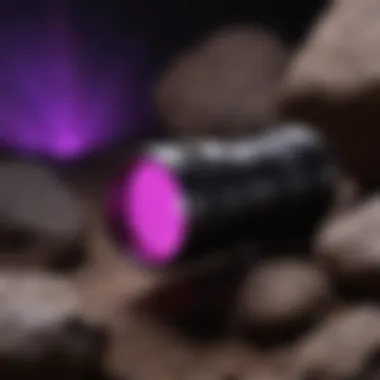
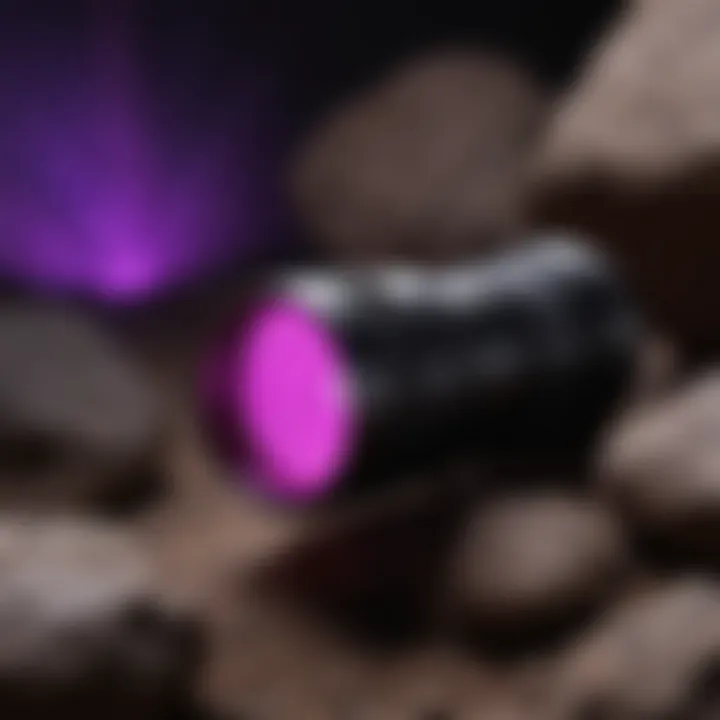
- Use a Soft Cloth: Gently wipe the lens with a microfiber cloth to remove dust or fingerprints. Avoid using abrasive materials that could scratch the surface.
- Lens Cleaner: If the lens is particularly dirty, a bit of lens cleaning solution can help. Just dab it on the cloth, not directly onto the lens.
- Check the Casing: Over time, grime can accumulate on the casing. A damp cloth with mild soap can restore its shine. Take care to avoid getting water into any openings.
- Inspect the Bulb: Occasionally, check the bulb for any damage or signs of wear. If it appears cloudy or discolored, it may need replacing. A clean bulb ensures bright output, crucial for spotting those subtle mineral fluorescences.
By paying attention to these details, you can extend the life of your flashlight—much like nurturing one’s prized collection of specimens.
Battery Management and Storage
Battery management is another critical component of maintaining blacklight flashlights. Proper handling and storage of batteries not only ensures the flashlight works when needed but also avoids the annoying inconvenience of a dead unit during an important field trip.
- Choose Quality Batteries: Investing in high-quality batteries, such as lithium-ion, can make a significant difference in performance and longevity.
- Rotate Batteries: If your flashlight uses multiple batteries, consider rotating their positions and replacements regularly. This step helps in leveling out wear and tear on each battery.
- Avoid Long-term Storage with Batteries Inside: If you're planning not to use your flashlight for an extended period, remove the batteries. This simple act can prevent leakage, which might ruin the internal components.
- Temperature Considerations: Store your flashlight and batteries at room temperature. Extreme temperatures can alter battery effectiveness and even damage the components.
"Regular maintenance can mean the difference between a trusty tool and a frustrating failure in the field. Always be prepared and care for your equipment as you would for your collection."
A little vigilance and effort in cleaning and managing your small blacklight flashlight can go a long way. By ensuring these tools are well cared for, you’re not only protecting your investment but also enhancing your exploring experience, making each outing more fruitful.
Common Misconceptions About Blacklight Flashlights
When you think about blacklight flashlights, what springs to mind? Many may conjure images of a darkened room, neon colors springing to life, or perhaps a tool only useful for detecting party stains. Unfortunately, these surface-level interpretations can overshadow the true versatility and critical applications of small blacklight flashlights. Understanding common misconceptions lays the groundwork for appreciating their full potential and, indeed, the myriad benefits they bring to different fields.
Distinguishing Myths from Facts
Yes, many enthusiastic rock and fossil hunters may shrug off blacklight flashlights as mere gimmicks, but that perspective is far too narrow. Let's unravel some of these myths, shall we?
- Myth: Blacklight flashlights are only for detecting organic residues.
Fact: While they’re certainly effective in unveiling those elusive biological stains, blacklight flashlights are incredibly useful in the geological realm, illuminating vibrant, fluorescent minerals that might otherwise remain hidden in plain sight. - Myth: The light emitted is just for fun, all aesthetic.
Fact: That glow isn’t just about creating a party atmosphere. In truth, the ultra-violet light reveals structural details in rocks and fossils, proving essential for collectors who wish to assess authenticity and condition. - Myth: Using blacklight is dangerous, especially for your eyes.
Fact: While caution is indeed warranted, safety measures are straightforward. Many small blacklight flashlights come equipped with safety features, and proper usage means limited risk to your vision. Always remember to wear protective eyewear when necessary.
"Knowledge is power, especially in the field of rock and fossil collection. Misunderstandings can lead to missed opportunities."
- Myth: They are too expensive for casual use.
Fact: There are many affordable options that don’t scrimp on quality. Finding the right model doesn’t have to break the bank. Even budget-friendly flashlights can unveil significant geological features for the astute collector.
In short, it seems clear: dismantling prevailing misconceptions is crucial for creating a more informed community of rock and fossil enthusiasts. Only by clarifying these misunderstandings can collectors fully unlock the potential of small blacklight flashlights in their pursuits. Being aware of these factors ensures a richer, more rewarding experience!
Safety Considerations
The use of small blacklight flashlights can be tremendously beneficial in various settings, yet safety should remain paramount. Understanding how to effectively and safely utilize these tools is crucial for anyone, particularly for rock and fossil collectors who may engage in activities that involve prolonged exposure to ultraviolet light. Given the powerful capabilities of blacklight flashlights, let's delve into some key elements to consider to ensure protection for oneself and others while using them.
Protective Measures When Using
When operating small blacklight flashlights, it’s essential to implement protective measures to minimize risks while enhancing the overall experience. Here are some practical tips:
- Wear safety goggles: Since UV light can cause damage to the eyes, like any good hobbyist, never skimp on eye protection. Opt for goggles specifically designed to block UV rays.
- Limit exposure time: Plan your activities in a way that reduces continuous exposure to the light source. It’s advisable to take breaks to ensure your skin and eyes are not being overexposed to harmful rays.
- Keep the flashlight away from skin: It's tempting to check for fluorescence closely, but never direct the light at exposed skin to avoid any possible irritation.
- Store appropriately: When not in use, keep the flashlight securely stored and out of reach of children. This will prevent accidental exposure or injury.
"Safety isn’t just about protection; it’s ensuring that exploration remains enjoyable and fruitful."
Implementing these protective measures can significantly decrease risks, allowing for safer exploration of rocks and fossils under the intriguing glow of blacklight technology.
Understanding UV Radiation Risks
Understanding the risks associated with ultraviolet radiation is critical for anyone who uses small blacklight flashlights. UV radiation is often categorized into three types: UVA, UVB, and UVC. Each has different implications for safety:
- UVA: This type poses the least risk, as it penetrates deeply into the skin, potentially accelerating skin aging but generally not causing immediate harm.
- UVB: More harmful than UVA, UVB rays can cause sunburn and have been linked to skin cancer. Prolonged exposure to high-intensity blacklight may result in similar effects.
- UVC: While UVC does not reach the Earth’s surface, it’s important to understand that certain artificial sources may emit UVC rays, which can be particularly damaging to skin and eyes.
To address these risks, always remember:
- Familiarize yourself with your flashlight’s specifications—know what type of UV light it emits.
- Avoid shining the light towards reflective surfaces, as this can increase exposure.
- Consider using additional protective gear, like UV-blocking clothing.
By keeping these considerations in mind, rock and fossil collectors can navigate their explorations with confidence while maintaining their health and safety.
Culmination
The exploration of small blacklight flashlights has opened a door to a myriad of applications across various fields, revealing their significance to both casual enthusiasts and professionals. This article has taken a deep dive into the multifaceted uses of these specialized tools, particularly focusing on the implications in areas such as geology, art verification, pest control, and forensic science.
The Lasting Impact of Small Blacklight Flashlights
Small blacklight flashlights are not merely gadgets; they are gateways to discovering the hidden aspects of the world around us. For rock and fossil collectors, these tools serve as an essential part of the toolkit, allowing them to uncover the fluorescent qualities of minerals. By shining ultraviolet light in the dark, it highlights phosphorescent characteristics that are invisible to the naked eye. Such qualities can change how we perceive the authenticity and condition of diverse geological specimens.
In the realm of art authentication, the impact of small blacklight flashlights is equally profound. Being able to investigate subtle markings or alterations that might indicate forgery is essential in a world where art values soar high. This technology provides collectors and appraisers with the means to assess the true worth of pieces based on scientific observations rather than mere intuition.
The portable nature of these flashlights means they can be taken anywhere—whether out in the field or examining items in a gallery. This mobility ensures that collectors are always prepared, with a reliable tool at their side whenever an opportunity for a closer look arises.
Moreover, understanding how to select the right small blacklight flashlight, maintain it, and apply it safely is crucial. The rise of misconceptions about UV radiation usage could discourage some users if the proper data is not shared. This article aims to dispel these misunderstandings, guiding readers toward best practices that ensure both effectiveness and safety in their pursuits.
Lastly, the ongoing interest in these flashlights signifies a larger trend: the intersection of science, art, and nature. As we blend disciplines, we develop a richer understanding of our environment and the artifacts that fill our lives. For rock and fossil enthusiasts, small blacklight flashlights have effectively transformed the way they interact with their collections and deepen their appreciation for nature's anomalies. Through the lens of this article, it becomes evident that the continual exploration of such tools can lead to profound revelations, enriching our experiences and knowledge in ways we might never have anticipated.
"Knowledge is not a destination; it's a journey brought to light by curiosity and the right tools."



